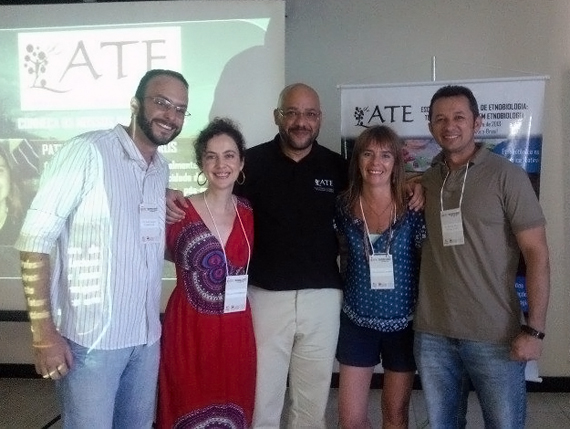Thinking Outside the Box about Weeds, Wildmeat, and More
Posted in Travelogue on April 17, 2014 by Ina Vandebroek
Ina Vandebroek, Ph.D., is an ethnomedical research specialist at The New York Botanical Garden‘s Institute of Economic Botany. One of her research interests is studying how immigrant populations in New York City use traditional plant-based remedies in their health care.

The science of ethnobiology studies the relationships among peoples, nature, and culture. It is a multidisciplinary field that uses methods from the social and natural sciences, including botany, ecology, agriculture, medicine, zoology, anthropology, archaeology and others. Ethnobiologists have diverse research interests, and an international conference presents a great opportunity to learn from specialists.
That was the case with the Advanced Topics in Ethnobiology Conference in Recife, Brazil, which I attended in December. The conference was organized and sponsored by the Laboratory of Applied and Theoretical Ethnobiology, led by Dr. Ulysses Albuquerque from the Universidade Federal Rural de Pernambuco.
The conference organizers made sure we had a full agenda for two days. I had the honor of giving the opening lecture, “Traditions and Transformations in Ethnobiology.” I noted that while the science of ethnobiology studies cultural traditions that are rooted in the deep historical connections between peoples and their environments, the field is witnessing many transformations of cultural knowledge and biological resources as a result of globalization, increasing urbanization, mobility, and modernization.
According to the World Health Organization, the majority of the world’s population now lives in cities. This demographic transition from rural to urban areas coincides with shifts from agriculture-based economies to mass industries, technology, and services. But ethnobiology teaches us that when humans move from rural to urban areas (within the same country or across national boundaries), they not only bring with them their cultural traditions but also the plants that they continue to use for self-medication and nutrition. One example: weeds, those commonly underappreciated plants, follow human migration patterns since they easily adapt to man-made environments. It is no wonder, therefore, that studies have shown weeds play an important role as herbal remedies.
I ended my talk with two “think outside the box” questions. The first question was, do we ethnobiologists embrace the importance of weeds—exotic and cosmopolitan plants—because they have shown themselves to be useful to humans? Or do we let the common perception of weeds as obnoxious, useless plants rule and focus our efforts on protecting native plants, as ecologists tend to tell us we should?
The second question relates to how ethnobiologists can take better advantage of the opportunities offered by globalization. Two things that come to mind as possibilities: increasing international collaborations through bilateral exchange of students and researchers and promoting virtual herbaria for remote identification of plant species. The virtual herbarium at The New York Botanical Garden can be accessed by anyone worldwide who has a computer and an Internet connection.
Here are some highlights from the conference:
Dr. Albuquerque discussed the applicability of a theory from ecology, called niche construction, to the field of ethnobiology. It turns out that humans are not that much different from beavers when it comes to shaping the environment to fit their own needs. While beavers construct dams, humans do it through the generation, transmission and application of cultural knowledge. A powerful message from Dr. Albuquerque’s presentation was that we humans modify our own evolution. Human inheritance is not only genetic and ecological but also cultural.
Dr. Nathalie Van Vliet from Denmark gave a talk about the importance of wildmeat consumption in Amazonia. This is meat obtained from hunting wild animals. It amazed me to learn that indigenous communities in the Amazon Basin harvest about 4 million tons of wildmeat annually. To give you a better idea how much that is, Europe produces 7.5 million tons of beef per year. But, because of globalization, the Amazon tropical rainforest is now witnessing increasing urbanization and expansion of markets. As a result, indigenous children living in more urbanized Amazonian regions are rapidly changing from a diet that relies on traditional (and more nutritious) wildmeat to one that is heavily based on processed chicken, eggs, beef, and pork. We are left to wonder how this more commercial diet will impact indigenous health in years to come.
The impressive closing lecture of the conference was given by Dr. Charles Clement from Brazil. Drawing on studies from archaeology and other disciplines, he made the case that indigenous communities intensively domesticated much of Amazonia long before the arrival of European colonizers. Due to the collapse of indigenous populations after the arrival of the Europeans, this important native Amazonian heritage of domestication has faded into myths and legends. Thus, contrary to popular belief, the Amazon rainforest as we know it may not be that pristine and untouched by humans after all.
These and the other lectures at the conference made the compelling case that ethnobiology can not only teach us something about the past but holds wisdom for the future as well.
The conference website with information about the speakers, program and abstracts of the lectures can be found at Etnobotanica Aplicada.

